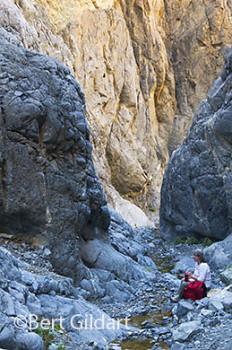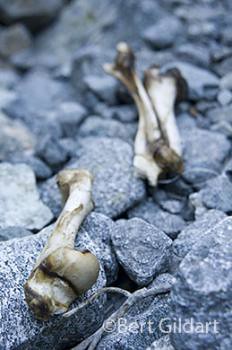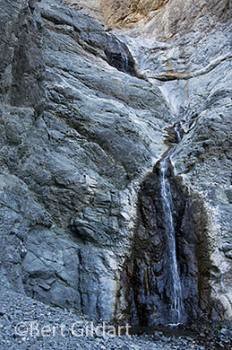Death Valley Can Kill
©Bert Gildart: Death Valley may be the hottest place on earth. On July 10, 1913, temperatures soared to 134 degrees at Furnace Creek, and “It was so hot,” one observer said, “that swallows were falling dead out of the sky”.

Tranquil, yes, but not always
The incredible heat that results each year is the result of essentially three factors. For one, the mountains are high and narrow, thereby trapping and holding the heat. The canyons are narrow and also trap the heat. Rather than rising and spewing into the atmosphere the heat sinks back into the valley. This compounds the situation, for as the air sinks it is compressed, an act which also generates heat and raises the temperature even further. Two other factors are the lack of moisture and the lack of vegetation.
DESPERATE TIMES
Yesterday, Janie and I discovered just what impact such heat can have on wildlife. Leaving our campground at Furnace Creek we drove 30 miles south to a trailhead at Willow Canyon, which had been recommended to us by the campground hostess. The trail leads 2.5 miles into a falls, and here is where we discovered how the lack of water can create desperation.

Desert Bighorn Sheep Bones
Desert bighorn sheep range throughout the park, but they need water, and when they desperately crave it panic sets in. That at least was our theory when we entered Willow Canyon and discovered that sheep bones littered the trail. Our only explanation was that sheep, sensing water from above, grew careless, slipped from the steep cliffs above and fell hundreds of feet to their deaths. Coyotes feasted, and then scattered the bones.
Though the February temperatures yesterday were in the 80s, our hike was a pleasant one, and when we reached the falls water was dropping over an expanse of about 50 feet. From here, it trickled through the canyon and then disappeared, meaning the only place water was available was in the short quarter-mile stretch.
WHAT KILLS?
Not only have sheep succumbed to the lack of water, but so have many people. Generally, people don’t die from heat exhaustion; rather they die from dehydration. On a typical June, July or August day, when the temperature has risen above 120°F, relative humidity might be little more than three percent.
With conditions such as these, on an average summer day a person can loose two gallons of water just sitting in the shade. Blood contains much water and this is the source of the water loss. The results are somewhat predictable: circulation becomes sluggish, muscles cramp and become fatigued, the head aches and it is a strain on the heart just to keep on pumping.
Losses of three gallons can have even more devastating affects. Your hearing goes and your eyes sink. With losses of four gallons, bloody cracks appear on your skin and generally death soon follows. Many have died here, but 1905 was the worst year when 13 men perished from thirst and water loss.

Moonrise over Willow Canyon
Despite the reminders of the need for water, our hike was inspiring. The canyon provided relief from the sun and on our return the moon was rising over the mountains surrounding Willow Canyon. It was just another reminder of how intriguing Death Valley can be–when explored at the right time of year.


